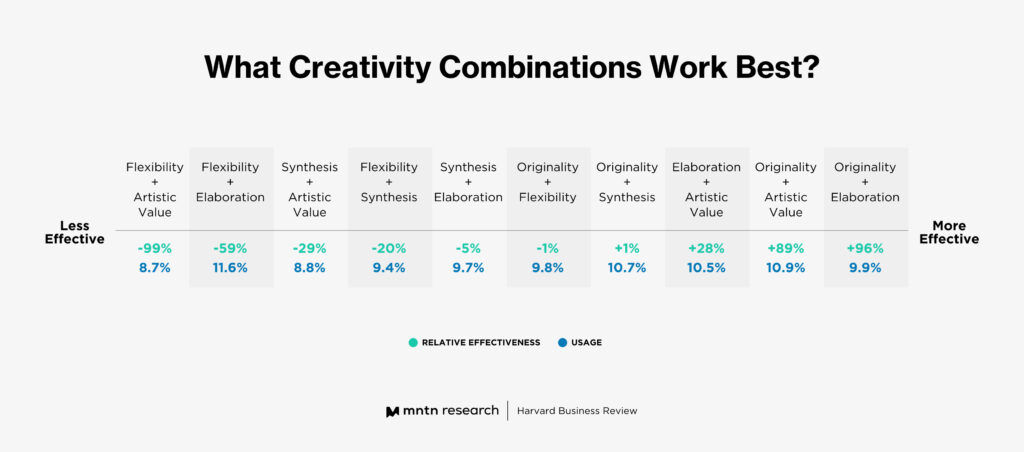Research Digest
Pick Your Mix: How to Determine Your Optimal Creative Mix on Connected TV
by Melissa Yap5 min read
Abstract
- A conservative creative approach ends up leaving more money on the table.
- However, coming up with original creative is not enough—originality boosts sales only in the presence of additional creative dimensions.
- Combining elaboration with originality resulted in almost twice the average impact on sales.
Often advertisers make the mistake of skipping a few steps before launching their Connected TV campaigns. Though we’ve covered the creative elements that are known to drive performance, there’s another question that brands need to answer before even getting to this step: “What type of message do I want to convey?”. In this article, we’ll answer this question by exploring the different types of creative approaches that brands can take in their Connected TV advertising campaigns and highlighting which combinations work best for driving performance.
What Makes “Good” Creative on Connected TV?
One challenge that has plagued the advertising industry is that ‘creativity’ is a somewhat subjective term. However, thanks to innovations in technology, this too can be measured and then applied to creative campaigns. Faris Yakob, author of Paid Attention: Innovative Advertising for a Digital World outlined a few concepts that brands can keep in mind for their next Connected TV campaign.
- Creative needs to be distinctive: Yakob recommends brands ask themselves when approaching any creative endeavor, “What are the creative conventions of the category and how might we challenge them?”. This can be achieved through any combination of visual, verbal or audio elements that are uniquely linked to the brand, such as logo, tagline, jingle, packaging shape—even to a brand character or mascot that encapsulates key values and creates immediate recognition.
- Creative needs to elicit emotion: “How does my creative work elicit emotion in order to maximize its commercial impact?” is the next question that should be addressed in any Connected TV campaign planning. Research by Orlando Wood, author of Look Out and Chief Innovation Officer at System1Group revealed that “left-brain tropes have become more dominant in advertising in the last decade.
“Flat, split screens, front-facing actors addressing the audience, staring, abstracted product features and body parts, words on screen, monologues and adjectives used as nouns are all more common in modern advertising and less effective at attracting attention, eliciting emotion and driving growth.” Meanwhile, right-brain features like facial expressions, human movement and touch, stories with characters that have agency, wordplay and metaphor, are less common but more effective.
Which Creative Combination Works Best?

A study by Harvard Business Research revealed there are five ‘dimensions’ of creativity:
- Originality: An ad composed of elements that are rare or surprising, or that move away from the obvious and commonplace. An original ad often diverges from norms or experiences by applying unique visual or verbal solutions.
- Flexibility: This highlights an ad’s ability to link the product to a range of different uses or ideas.
- Elaboration: When an ad contains unexpected details or extends simple ideas so that they become more intricate and complicated. For example, in one ad for Wrigley’s 5 gum, a man is submerged in tiny metal balls that bounce off his skin to represent the tingle one feels while chewing the gum.
- Synthesis: Blending or connecting normally unrelated objects or ideas. Who could forget the Heinz ad featuring a stampede of Dachshunds?
- Artistic value: It’s hard to replicate the artistic creativity (not to mention, production value) of verbal, visual, or sound elements. This results in consumers viewing the ads as almost a piece of art—and that memory stays in the viewer’s mind long after the ad has aired.
In this study, 437 TV advertising campaigns for 90 consumer goods brands in Germany were screened to a panel of viewers to assess the creativity of the ads, and the relationships between their perceptions and sales figures for the products. Some key findings include:
- A highly creative ad campaign had, on average, nearly double the sales of a non-creative campaign. The impact of creativity was initially relatively small but typically gathered momentum as the campaign rolled out.
- Variation in sales impact among the combinations was even greater than the variation between individual dimensions. For example, combining elaboration with originality had almost double the average impact on sales, followed by artistic value and originality.
- Originality is often part of the most effective combinations, however it only boosts sales in the presence of additional creative dimensions.
- Some combinations of creativity work better than others depending on the product category. In categories such as cola and coffee, advertisers and customers tend to favor higher levels of creativity, whereas in categories such as shampoo, body care, and facial care, campaigns focus on showing the actual use of the product to deliver product benefits and features. However, if the product is tied to personal preferences (like quenching thirst with a soda), an out-of-the-ordinary approach can be more effective.
Conclusion
Brands should take a step back when approaching their Connected TV campaigns by understanding the different types of creative variables (not to be mistaken by creative elements) that will drive performance. Firstly, there are two key components that define a successful CTV ad, as the creative needs to be both distinctive and emotive. Secondly, there are five dimensions that make up the hallmarks of ‘creativity’—originality, flexibility, elaboration, synthesis, artistic value. Oftentimes, originality makes up the most effective combinations, however it only works effectively in combination with other creative dimensions. Depending on your product or service category, it’s important to understand your category’s sensitivity to creativity as this will impact your overall campaign performance.
Subscribe to the MNTN Research Weekly
Sign up to receive a weekly feed of curated research, sent straight to your inbox.
Resources
1 Principles of Creative Effectiveness or What Is ‘Good Creative’ Anyway? (WARC)
2 Creativity in Advertising: When It Works and When It Doesn’t (Harvard Business Review)